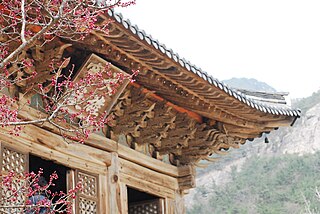
North Jeolla Province, officially Jeonbuk State, is a Special Self-governing Province of South Korea in the Honam region in the southwest of the Korean Peninsula. Jeonbuk borders the provinces of South Chungcheong to the north, North Gyeongsang and South Gyeongsang to the east and South Jeolla to the south.

South Jeolla Province, also known as Jeonnam (전남), is a province in the Honam region, South Korea, and the southernmost province in mainland Korea. South Jeolla borders the provinces of North Jeolla to the north, South Gyeongsang to the northeast, and Jeju to the southwest in the Korea Strait.

Iksan is a city and major railway junction in North Jeolla Province, South Korea.

Jeolla Province was one of the historical Eight Provinces of Korea during the Kingdom of Joseon in southwestern Korea. It consisted of the modern South Korean provinces of North Jeolla, South Jeolla and Gwangju Metropolitan City as well as Jeju Province. The provincial capital was Jeonju, the current capital of North Jeolla. The entire inland region was called Honam, which is still commonly used today.

Honam is a region coinciding with the former Jeolla Province in what is now South Korea. Today, the term refers to Gwangju, South Jeolla Province, Jeju Province and Jeonbuk State. The name "Jeonla-do" is used in the names of the Honam railway line and Honam Expressway, which are major transportation corridors connecting Seoul and Daejeon to the Honam region. The name is often used to refer to people residing in the region. There is also Honam University, which is located in Gwangju, the biggest city in Honam.
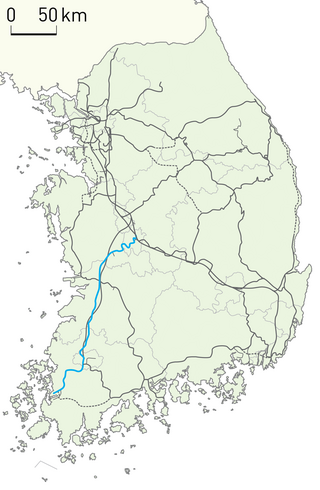
The Honam Line is a major railway line serving the Honam region in South Korea. The line is served by frequent passenger trains from Seoul to Gwangju and Mokpo.

The Jeolla Line (Korean: 전라선) is a railway line in North and South Jeolla Provinces in South Korea. The line is served by frequent passenger trains from Seoul to Yeosu.
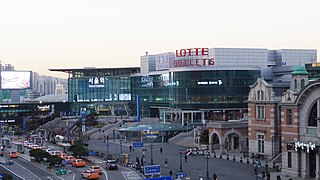
Seoul Station (Korean: 서울역) is a major railway station in Seoul, the capital of South Korea. The station is served by the Korail Intercity Lines and the commuter trains of the Seoul Metropolitan Subway.

The Gyeongjeon Line (Korean: 경전선) is a railway line serving South Gyeongsang and South Jeolla Provinces in South Korea. It covers a total of 300.6 km, from Samnangjin Station in Miryang, South Gyeongsang, to Gwangju Songjeong Station in Gwangju, South Jeolla.

Iksan station is on South Korea's high-speed KTX railway network, 243 km south of Yongsan station.

Suncheon station is a railway station in South Korea. It is on the Gyeongjeon Line and the Jeolla Line.
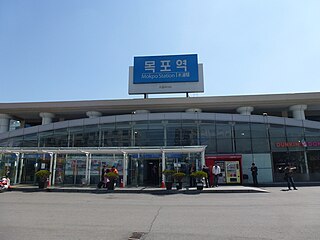
Mokpo station is a station on the Honam Line in Mokpo, South Jeolla Province. It is the westernmost railway station in South Korea. This station is the last stop on the Honam Line. Being located in the southwestern part of the Korean peninsula, it is used by customers who visit Jeju Island, Heuksan Island, and Hong Island in connection with KTX.
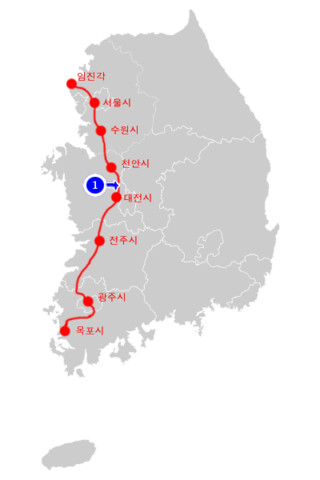
National Route 1(Korean: 국도 제1호선; RR: Gukdo Je Il Hoseon) is a national highway in South Korea. It connects Mokpo, South Jeolla Province with the city of Paju in Gyeonggi-do. Before the division of the Korean peninsula, the highway ran until Sinuiju, North P'yongan Province, in present-day North Korea.
High-speed rail service in South Korea began with the construction of a high-speed line from Seoul to Busan in 1992, and was inspired by Japan's Shinkansen. The first commercial high-speed rail service was launched on 1 April 2004. Currently, South Korea hosts two high-speed rail operators: Korea Train eXpress (KTX) and Super Rapid Train (SRT).

Yeosu Expo station is a KTX station in the city of Yeosu, South Jeolla Province, South Korea. It is on the Jeolla Line.

Guryegu station is a KTX station in the city of Suncheon, South Jeolla Province, on the southern coast of South Korea. It is on the Jeolla Line.

Namwon station is a KTX station in the city of Namwon, North Jeolla Province, on the southern coast of South Korea. It is on the Jeolla Line.
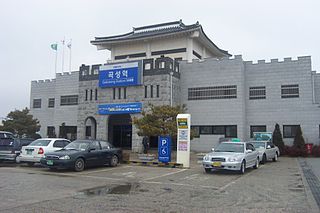
Gokseong station is a KTX station in the county of Gokseong, South Jeolla Province, on the southern coast of South Korea. It is on the Jeolla Line.
This page is based on this
Wikipedia article Text is available under the
CC BY-SA 4.0 license; additional terms may apply.
Images, videos and audio are available under their respective licenses.

















